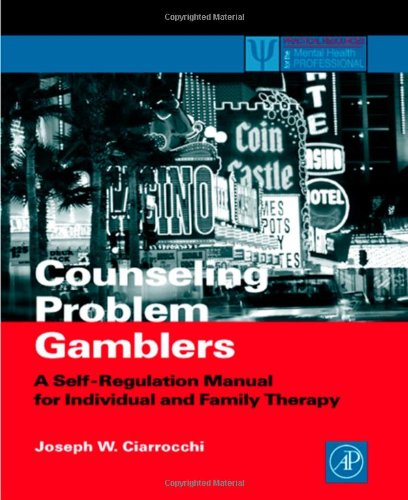Clinical research on gambling is quite primitive in comparison with research on other addictions or mental disorders. Almost no controlled clinical outcome studies exist, nor does most research have even a comparison group to give the reader a sense of how problem gamblers differ from other distressed groups. With next to no government research funding and little interest from the academic community, what was learned in the first twenty years came mostly from clinical insights of practitioners or preliminary data collection from clinicians with an empirical bent. However, following the seminal work of Robert Custer (Custer & Milt, 1985), clinicians working in the hospital programs with gamblers published descriptive research on problem gambler characteristics, family environments, spouse relationships, personality patterns, and dual addiction issues (Ciarrocchi, 1987; Ciarrocchi & Hohmann, 1989; Ciarrocchi & Richardson, 1989; Ciarrocchi et al., 1991; Ciarrocchi, 1993; Ciarrocchi & Reinert, 1993; Russo et al., 1984; Taber et al., 1987). Lacking the necessary funding for rigorously controlled studies, gambling research has made slow progress. A recent U.S. congressional initiative to study the impact of problem gambling may change this picture. The commission’s recently released report (National Gambling Impact Study Commission, 1999 [online at http://www.ngisc.gov/]) with its vast literature review (National Academy Press, 1999 [online at http://www.nap.edu]) and new population survey (National Opinion Research Center, 1999 [online at http://www.norc.uchicago.edu/]) may provide an impetus for significant research funding. In the meantime, we need to rely on clinical wisdom to understand problem gambling and how it differs from other addictions and mental disorders. Custer often remarked that problem gambling was about 80% similar to substance abuse, but he always added that understanding the 20% difference was crucial. The empirical literature (Chapter 4), however, has not identified as yet that 20%, so we are left to ponder clinical experience.
چکیده فارسی
تحقیقات بالینی در مورد قمار در مقایسه با تحقیقات در مورد سایر اعتیادها یا اختلالات روانی کاملاً ابتدایی است. تقریباً هیچ مطالعه پیامد بالینی کنترلشدهای وجود ندارد، و اکثر تحقیقات حتی یک گروه مقایسه ندارند تا به خواننده این حس را بدهد که قماربازان مشکلدار چگونه با سایر گروههای مضطرب تفاوت دارند. بدون هیچ بودجه تحقیقاتی دولتی و علاقه کمی از سوی جامعه دانشگاهی، آنچه در بیست سال اول آموخته شد، بیشتر از بینش بالینی پزشکان یا جمع آوری داده های اولیه از پزشکان با گرایش تجربی حاصل شد. با این حال، به دنبال کار اصلی رابرت کاستر (کاستر و میلت، 1985)، پزشکانی که در برنامه های بیمارستانی با قماربازان کار می کردند، تحقیقات توصیفی را در مورد ویژگی های قمارباز مشکل دار، محیط های خانوادگی، روابط همسر، الگوهای شخصیتی و مسائل اعتیاد دوگانه منتشر کردند (سیاروکی، 1987). Ciarrocchi & Hohmann، 1989؛ Ciarrocchi & Richardson، 1989؛ Ciarrocchi و همکاران، 1991؛ Ciarrocchi، 1993؛ Ciarrocchi & Reinert، 1993؛ Russo et al.، 1984؛ Taber 1987). تحقیقات قمار به دلیل کمبود بودجه لازم برای مطالعات دقیق کنترل شده، پیشرفت کندی داشته است. ابتکار اخیر کنگره ایالات متحده برای مطالعه تأثیر قمار مشکل دار ممکن است این تصویر را تغییر دهد. گزارش اخیر کمیسیون (کمیسیون ملی مطالعه تأثیر قمار، 1999 [آنلاین در http://www.ngisc.gov/]) با بررسی ادبیات گسترده آن (انتشارات آکادمی ملی، 1999 [آنلاین در http://www.nap). edu]) و نظرسنجی جدید جمعیت (مرکز ملی تحقیقات افکار، 1999 [آنلاین در http://www.norc.uchicago.edu/]) ممکن است انگیزه ای برای بودجه تحقیقاتی قابل توجهی فراهم کند. در این میان، برای درک مشکل قمار و تفاوت آن با سایر اعتیادها و اختلالات روانی باید به خرد بالینی تکیه کنیم. کاستر اغلب اظهار داشت که قمار مشکل دار تقریباً 80٪ شبیه سوء مصرف مواد است، اما او همیشه اضافه می کرد که درک این تفاوت 20٪ بسیار مهم است. با این حال، ادبیات تجربی (فصل 4)، هنوز آن 20٪ را شناسایی نکرده است، بنابراین ما باید به تجربه بالینی فکر کنیم.
ادامه ...
بستن ...
Clinical research on gambling is quite primitive in comparison with research on other addictions or mental disorders. Almost no controlled clinical outcome studies exist, nor does most research have even a comparison group to give the reader a sense of how problem gamblers differ from other distressed groups. With next to no government research funding and little interest from the academic community, what was learned in the first twenty years came mostly from clinical insights of practitioners or preliminary data collection from clinicians with an empirical bent. However, following the seminal work of Robert Custer (Custer & Milt, 1985), clinicians working in the hospital programs with gamblers published descriptive research on problem gambler characteristics, family environments, spouse relationships, personality patterns, and dual addiction issues (Ciarrocchi, 1987; Ciarrocchi & Hohmann, 1989; Ciarrocchi & Richardson, 1989; Ciarrocchi et al., 1991; Ciarrocchi, 1993; Ciarrocchi & Reinert, 1993; Russo et al., 1984; Taber et al., 1987). Lacking the necessary funding for rigorously controlled studies, gambling research has made slow progress. A recent U.S. congressional initiative to study the impact of problem gambling may change this picture. The commission’s recently released report (National Gambling Impact Study Commission, 1999 [online at http://www.ngisc.gov/]) with its vast literature review (National Academy Press, 1999 [online at http://www.nap.edu]) and new population survey (National Opinion Research Center, 1999 [online at http://www.norc.uchicago.edu/]) may provide an impetus for significant research funding. In the meantime, we need to rely on clinical wisdom to understand problem gambling and how it differs from other addictions and mental disorders. Custer often remarked that problem gambling was about 80% similar to substance abuse, but he always added that understanding the 20% difference was crucial. The empirical literature (Chapter 4), however, has not identified as yet that 20%, so we are left to ponder clinical experience.
ادامه ...
بستن ...










